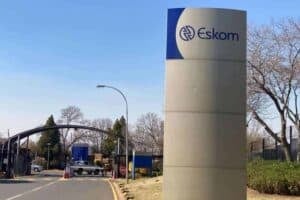DA’s application is a charter for lawlessness, says utility’s finance head.

Efforts by the Democratic Alliance (DA) and the Tebeila Institute of Leadership, Education, Governance and Training to prevent the implementation of the 18.65% increase in Eskom’s revenue granted by energy regulator Nersa will cause irreparable harm to the economy, according to the utility’s CFO Calib Cassim.
In an affidavit filed last week, Cassim calls the urgent applications, which may be heard together early in March, “simplistic and myopic”.
ALSO READ: ‘Choose between buying food or electricity’ – DA seeks interdict against Nersa’s tariff hike
A search of the latter term shows it to mean ‘short-sighted’ or ‘blind as a bat’, among other definitions.
The two parties launched their applications shortly after Nersa announced on 12 January that it has granted Eskom revenue totalling R319 billion in 2023/24 and R352 billion in the following year. This translates to increases of 18.65% and 12.74% in the amounts the utility is entitled to recover from electricity tariffs in those years.
Pressure
This came against the backdrop of intense and continuous load shedding that is costing the economy dearly, as businesses and households spend large amounts to supplement the power supply from Eskom or suffer heavy financial losses.
Consumers are at the same time suffering the impact of increasing interest rates, very low economic growth and rising prices of especially food products.
Nersa’s announcement led to a public outcry about rising electricity costs while supply is ever deteriorating.
The two applications were filed even before Nersa published the reasons for its decision last week.
Cassim points out that Eskom’s tariffs for 2023/24 have however not yet been set. He says the applicants are conflating Nersa’s determination of its revenue and the approval of tariffs, while the latter has not yet taken place.
In addition, setting aside the revenue determination does not allow Eskom to simply continue to charge consumers at current tariff levels – it would leave Eskom without any revenue. This would be catastrophic and detrimental to the very people the applicants are trying to protect, as well as the economy as a whole, he says.
The poor are ‘insulated’
Cassim further points out that the applicants argue that the increase will hit poor electricity users, ignoring the fact that government provides 50kWh of free basic electricity to the poor, insulating them from the increase.
In addition, many of the consumers the applicants want to protect receive their electricity not directly from Eskom, but from municipalities that add a significant margin to the Eskom tariffs.
Cassim rejects the DA’s argument that by granting this latest increase, Nersa has deviated from its own policy of granting tariffs that must be subsidised by Eskom.
He explains in his affidavit that the Electricity Regulation Act, the Electricity Pricing Policy and Nersa’s own methodology require the regulator to enable an efficient licensee (Eskom) to recover the cost of its operations, plus a reasonable return on assets.
He shows that Nersa has been acting unlawfully by failing to do that over many years, as has been confirmed by several court rulings in Eskom’s favour.
It will be a “charter for lawlessness” if the DA application is granted, he states.
Cassim also rejects the DA’s argument that it is wrong for Nersa to award more money to a failing state institution and says the decision is bringing Nersa closer to cost-reflective tariffs, which will help Eskom to become financially sustainable.
He shows that Nersa’s failure to allow Eskom to recover its costs from tariffs is the main factor that led to its current financial distress.
To continue its operations and fulfil its mandate, Eskom mitigates against the shortfall by borrowing money, Cassim said.
He disclosed that at the end of December Eskom’s debt had reached R422 billion, with little room to increase it further.
Eskom’s annual and cumulative revenue shortfall after tax and interest (R billion)

This is putting increasing pressure on the national fiscus, which is guaranteeing R350 billion of the debt, billions of which have already been committed.
If Eskom defaults on one of its loans it could trigger the acceleration of its full liability as well as, catastrophically, that of the state as guarantor, with a total liability of about R4 trillion; R412 billion of that is international debt, Cassim stated.
He said as matters stand, Eskom is expecting all its financial indicators to deteriorate in the coming financial year and huge debt repayments will be due in the next three years, with limited ability to borrow more.
Not a case of ‘thumb-suck’ figures
Cassim said the DA in its application creates the impression that Nersa came to its decision by a mere thumb-suck. That is however not the case. Significant amounts of the allowed revenue were in fact the result of court rulings.
He said the application is “at war with itself” as it complains of load shedding while attacking the increase in revenue that will assist Eskom in reduce load shedding.
This article originally appeared on Moneyweb and was republished with permission.
Read the original article here.
NOW READ: Electricity tariff hikes add to SA woes






